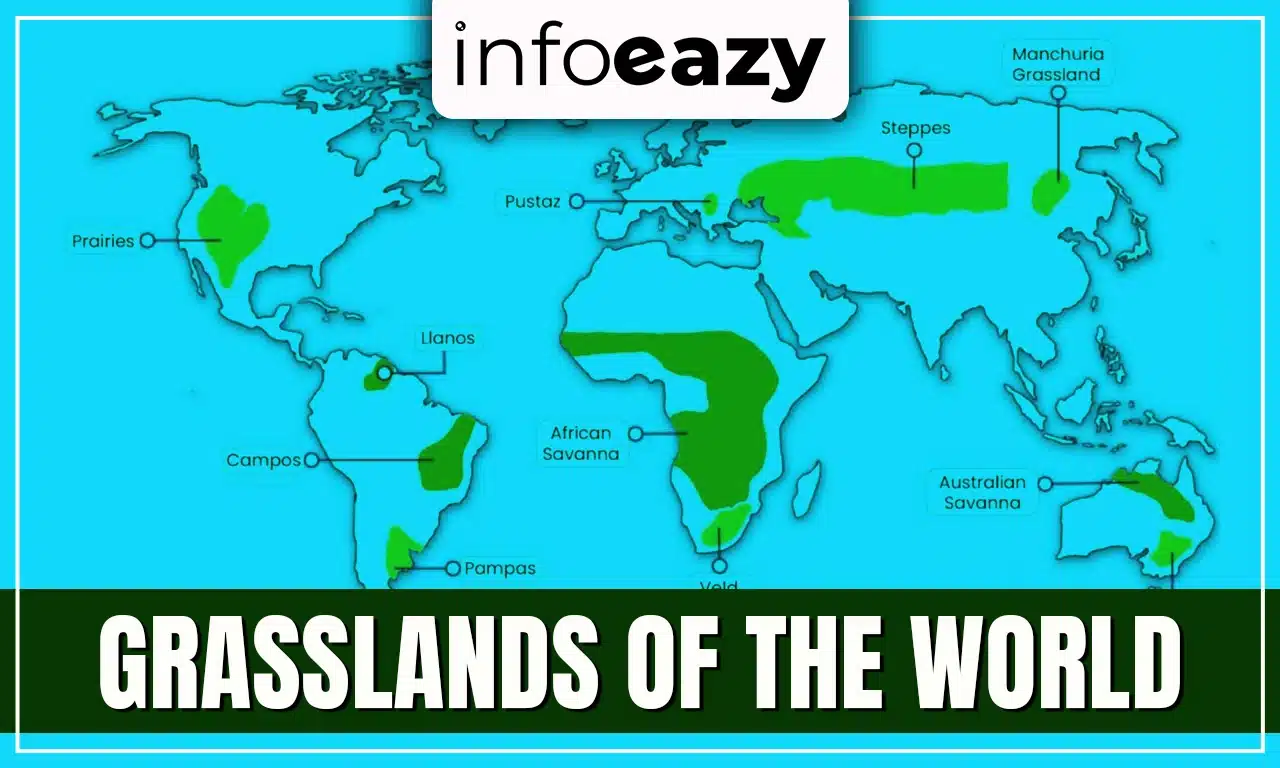Grasslands are one of the most extensive terrestrial ecosystems, covering about one-third of the Earth’s land area. Known for their open landscapes dominated by grasses, these regions are vital for biodiversity, climate regulation, agriculture, and human survival. They stretch across Africa, Asia, North and South America, Australia, and parts of Europe.
From the African savannas filled with lions and elephants to the North American prairies famous for bison, grasslands provide food, shelter, and resources for both humans and wildlife. Let’s explore their meaning, features, types, and a complete list of major grasslands of the world with their countries.
What are Grasslands?
Grasslands are large areas where grasses form the dominant vegetation. They occur in regions with moderate rainfall, generally between 25 cm and 75 cm annually. This rainfall is insufficient for supporting dense forests but more than enough to prevent deserts.
They are highly significant as they support large herds of herbivores such as zebras, bison, antelopes, and kangaroos, along with predators like lions and cheetahs. For humans, they are crucial agricultural hubs producing wheat, maize, and barley.
Features of Grasslands
Grasslands have some unique features that distinguish them from forests and deserts. They are mostly treeless landscapes dominated by grasses, herbs, and occasional shrubs. The detailed features have been listed below.
- Vegetation: Mostly grasses, herbs, and scattered shrubs; very few trees.
- Rainfall: Moderate, with seasonal variations.
- Climate: Tropical grasslands remain warm throughout the year; temperate grasslands experience hot summers and cold winters.
- Soil: Very fertile, rich in humus (especially in temperate regions).
- Wildlife: Home to grazing animals such as bison, zebras, antelopes, kangaroos, giraffes, and predators like lions, cheetahs, and wolves.
- Human Use: Agricultural hubs producing wheat, maize, barley, oats, and rice.
Types of Grasslands
Grasslands are broadly classified into two main types: tropical grasslands and temperate grasslands. Each type differs in climate, vegetation, and wildlife, depending on where they are found.
1. Tropical Grasslands
- Found near the equator in regions of Africa, South America, and parts of Asia.
- Remain warm throughout the year with distinct wet and dry seasons.
- Vegetation consists of tall grasses with scattered trees or shrubs.
- Famous examples include the Savannas of Africa, Campos of Brazil, and Llanos of Venezuela.
- Rich in wildlife such as lions, elephants, zebras, giraffes, and antelopes.
2. Temperate Grasslands
- Found in mid-latitude regions such as North America, South America, and Eurasia.
- Experience hot summers and cold winters, with moderate rainfall.
- Vegetation is mainly short and medium grasses, with very few or no trees.
- Known for highly fertile soil, making them important agricultural zones.
- Examples include the Prairies of North America, Pampas of Argentina, Steppes of Eurasia, and Downs of Australia.
3. Cold/Alpine Grasslands
- Located in high-altitude regions and polar areas where temperatures remain low.
- Vegetation is mostly mosses, lichens, and short grasses adapted to freezing climates.
- These grasslands have a very short growing season due to extreme cold.
- Provide grazing grounds for animals like yaks, reindeer, musk oxen, and wild sheep.
- Examples: Tundra (Arctic regions – Alaska, Canada, Russia), Alpine Meadows (Tibet, Nepal, Bhutan, Himalayas).
Types of Grasslands of the World: Comparison
Here is the comparison table of different Types of Grasslands of the World.
| Types of Grasslands of the World: Comparison | |||
| Feature | Tropical Grasslands | Temperate Grasslands | Cold/Alpine Grasslands |
| Location | Near the equator (Africa, South America, Asia) | Mid-latitudes (North America, South America, Eurasia, Australia) | High altitudes & polar regions (Arctic, Himalayas, Tibet) |
| Climate | Warm throughout the year; distinct wet & dry seasons | Hot summers and cold winters; moderate rainfall | Cold to freezing; very short growing season |
| Vegetation | Tall grasses with scattered trees/shrubs | Short/medium grasses; very few or no trees | Mosses, lichens, short grasses, alpine plants |
| Soil Fertility | Moderate; suitable for grazing | Very fertile, rich in humus, ideal for farming | Thin, poor, frozen soil (permafrost in tundra) |
| Wildlife | Lions, elephants, giraffes, zebras, antelopes | Bison, antelope, wild horses, wolves, coyotes | Yak, reindeer, musk oxen, snow leopard, ibex |
| Examples | Savanna (Africa), Llanos (Venezuela), Campos (Brazil) | Prairies (USA, Canada), Pampas (Argentina), Steppes (Russia), Downs (Australia) | Tundra (Arctic), Alpine Meadows (Himalayas, Tibet, Nepal, Bhutan) |
List of Grasslands of the World
Grasslands are spread across every continent and known by different names depending on the region. Below is a detailed list of major grasslands with their locations and type:
| List of Grasslands of the World | ||
| Grassland Name | Country/Region | Type |
| Savanna | Africa (Kenya, Tanzania, South Africa, etc.) | Tropical |
| Veld | South Africa | Tropical |
| Sudan Grasslands | Sudan, South Sudan, Chad | Tropical |
| Prairies | USA, Canada | Temperate |
| Pampas | Argentina, Uruguay, Brazil | Temperate |
| Campos | Brazil | Tropical |
| Llanos | Venezuela, Colombia | Tropical |
| Steppe | Russia, Ukraine, Mongolia, Kazakhstan | Temperate |
| Downs | Australia | Temperate |
| Canterbury Plains | New Zealand | Temperate |
| Highveld | South Africa | Tropical |
| Rangelands | Australia | Temperate |
| Tundra Grasslands | Arctic regions (Alaska, Canada, Russia) | Cold |
| Puszta | Hungary | Temperate |
| Alpine Meadows | Tibet, Nepal, Bhutan | Cold/Alpine |
Grasslands of the World FAQs
Q1. Which is the largest grassland in the world?+
Q2. What are the two main types of grasslands?+
Q3. Why are grasslands important?+
Q4. Which grasslands are found in South America?+
Q5. Which crops are commonly grown in grasslands?+
Tags: Grasslands of the World




